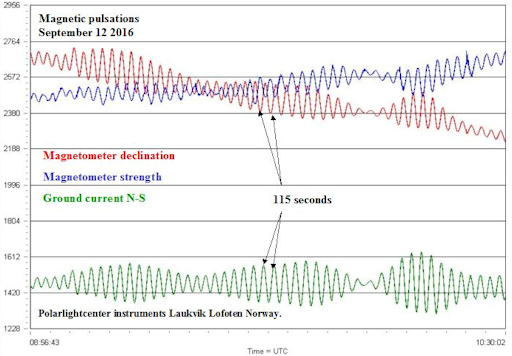|
|
Post by sainte on Sept 15, 2016 4:15:04 GMT
|
|
|
|
Post by sainte on Sept 15, 2016 4:35:45 GMT
This is well worth the read. Resonates strongly with me. Lisa is a true star. Amazing..
|
|
|
|
Post by sainte on Sept 15, 2016 4:37:04 GMT
Look Bedeep, I quoted.. Burp.. Do I get a cookie?  |
|
|
|
Post by aquariann on Sept 15, 2016 14:31:34 GMT
From spaceweather: EARTH'S MAGNETIC FIELD RINGS LIKE A BELL: In the Lofoten Islands of Norway, Spaceweather.com reader Rob Stammes operates a magnetic observatory. Twnty-four hours a day, he measures the strength and direction of the local magnetic field as well as electrical currents running through the ground. During geomagnetic storms, his chart recordings go haywire. On Sept. 12th, something different happened. They rang like a bell:  "During the morning and especially around noon, sinusoidal pulsations appeared on my instruments," says Stammes. "The period was close to 115 seconds (8.7 mHz)." These are natural ultra-low frequency oscillations known to researchers as "pulsations continuous" (Pc). The physics is familiar to anyone who has studied bells or resonant cavities. Earth's magnetic field carves out a cavity in the surrounding solar wind. Pressure fluctuations in the solar wind can excite wave modes in this cavity much like Stammes observed. References: #1, #2, #3. The magnetic oscillations of Sept. 12th were Pc4 waves. In other words, their frequency fell in the range 6.7–22 mHz. Pc4 waves, and their even lower frequency cousins Pc5 waves (1.7–6.7 mHz), can energize particles in Earth's inner magnetosphere because these frequencies match and reinforce the natural motion of particles around the geomagnetic field. It's a resonance phenomenon--like pushing a child on a swing. Matching the time of each push to the natural period of the swing energizes the system and sends the child swinging high in the air. Perhaps it is no surprise, then, that bright auroras were observed on both Sept. 11th and 12th. |
|